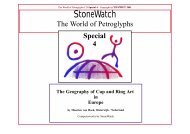StoneWatch The World of Petroglyphs
StoneWatch The World of Petroglyphs
StoneWatch The World of Petroglyphs
Sie wollen auch ein ePaper? Erhöhen Sie die Reichweite Ihrer Titel.
YUMPU macht aus Druck-PDFs automatisch weboptimierte ePaper, die Google liebt.
Als Teile 23 und 24 des <strong>StoneWatch</strong> CD-Atlas‘ erschienen 2002 auf der CD Nr. 7 zwei Arbeiten, in denen<br />
Felsbild-Neufunde sowohl aus dem südöstlichen Bergland von Ifedaniouène wie auch aus den Bergen<br />
des Aharhar Tasset (beide: Tassili / Süd-Algerien) vorgestellt wurden (HALLIER + HALLIER 2002a,b).<br />
(s.Karte)<br />
Diese zwei Berichte über Felsbild-Neufunde im SW-Tassili sollen nunmehr fortgesetzt werden; die<br />
Nummerierung der Abbildungen der beiden Teile I wird in den folgenden Teilen II fortgesetzt.<br />
Wir sind in unseren bisherigen Publikationen stets nach dem Grundsatz vorgegangen, möglichst alle –<br />
auch unvollendete, unverständliche, missglückte und defekte – Felsbilder einer Fundstelle zu publizieren<br />
(HALLIER 990).<br />
Danach sind wir auch bei den hier vorgelegten Aufsätzen vorgegangen, denn häufig wurden und werden<br />
noch heute nur Bilder einer bestimmten „Qualität“ oder eines Motivs veröffentlicht und allzu <strong>of</strong>t werden<br />
diese Bilder zudem nach einem bestimmten, meist subjektiven Ästhetik-Verständnis ausgewählt.<br />
Eine solche subjektive Bildauswahl führt in den meisten Fällen zwangsläufig zu einer ebenso subjektiven,<br />
den Leser irreführenden Prägung eines Fundplatzes und verfälscht so den tatsächlichen Charakter eines<br />
Fundplatzes und damit seine Interpretation.<br />
Felsbild-Neufunde im Bergland von Ifedaniouène, Teil II<br />
Wie bereits in Teil I dieser Arbeit festgestellt, finden sich im Bergland von Ifedaniouène vor allem<br />
Bildzeugnisse der Jüngeren Rinderzeit / Pferdezeit.<br />
Allerdings muss diese Region auch noch früher den Menschen schon interessanten Lebensraum geboten<br />
haben, wie die Felsbilder anzeigen: vgl. z.B. eine Rinderherde der Mittleren Rinderzeit (HALLIER +<br />
HALLIER 200 /2002: 2 ff., Pl.R-V; 2002a: 3ff., Abb. 25ff.) etwa bei 25°25‘N / 07°34‘E, aber auch die<br />
an anderer Stelle bereits publizierten Bilder der Rundkopf-Zeit (HALLIER + HALLIER 2000: 54ff.,<br />
Pl.M-O; 2003, 2004/2005, 2005).<br />
Unter einem Abri in den östlichen Bergen von Ifedaniouène (25°26‘N / 07°33‘E) zieht die für die Jüngere<br />
Rinderzeit sehr charakteristische Rinderherde von Abb. 67: eine Reihe von Rindern, gemalt in dem in<br />
dieser Zeit häufig verwendeten sehr rotbraunen Ocker. Als Maßstab kann das 25 cm lange gestreifte Rind<br />
ganz links dienen.<br />
Neben der Farbe sind typisch für diese Periode auch die nicht ganz stimmige Proportionierung der Tiere,<br />
die Art der Huf- und Horndarstellung und die sehr schematische Fellzeichnung der beiden letzten Tiere<br />
der Herde.<br />
Auch die Malweise des zugehörigen 11 cm großen Hirten auf Abb. 68 passt gut in diese Zeit. Die drei<br />
Tiere auf Abb. 68 zeigen mit ihren Eutern, dass in dieser Zeit weibliche Tiere eine größere Rolle zu spielen<br />
begannen: wahrscheinlich ein Anzeichen für die wachsende Bedeutung der Milchwirtschaft.<br />
In 2002 two articles were published (on CD no. 7, as parts 23 and 24 <strong>of</strong> the „Stone Watch CD-Atlas”)<br />
which presented new-found rock paintings <strong>of</strong> the southeastern Ifedaniouène Mountains and also from<br />
the mountains <strong>of</strong> the Aharhar Tasset (both: Tassili Mountains / South-Algeria) (HALLIER + HALLIER<br />
2002a,b). (s.map)<br />
<strong>The</strong>se two articles (parts I) about new findings <strong>of</strong> rock art sites in the southwestern Tassili are to be<br />
continued by the following parts II. <strong>The</strong> numbering <strong>of</strong> the figures <strong>of</strong> the parts I is continued.<br />
In our publications we followed up to now always the principle to publish as much as possible all the rock<br />
art found on a site – even unfinished, incomprehensible, failed and damaged specimens (HALLIER 1990).<br />
We followed the same principle also with the articles presented here.<br />
Very <strong>of</strong>ten only pictures <strong>of</strong> a certain “quality” or <strong>of</strong> selected motives were - and are up to now – published and<br />
additionally pictures are too <strong>of</strong>ten selected following a certain – in most cases subjective - understanding<br />
<strong>of</strong> aesthetics.<br />
Such a subjective selection <strong>of</strong> pictures leads in most cases inevitably to a subjective character <strong>of</strong> a site.<br />
This will mislead the reader and falsify the effective character <strong>of</strong> a site, thus falsifying also the site’s<br />
interpretation.<br />
New Paintings in the Ifedaniouène Mountains, part II.<br />
As already stated in part I <strong>of</strong> this article the Ifedaniouène Mountains exhibit above all pictures <strong>of</strong> the<br />
Younger Cattle Period / Horse Period.<br />
In fact this region must have <strong>of</strong>fered much earlier already an interesting environment to man. This is<br />
shown clearly by the existing rock art: See e.g. a cattle herd <strong>of</strong> the Middle Cattle Period (HALLIER +<br />
HALLIER 2001/2002: 121ff., pl.R-V; 2002a: 3ss., fig. 25ss.) approximately at 25°25‘N / 07°34‘E, but see<br />
also the paintings <strong>of</strong> the Roundhead Period published elsewhere (HALLIER + HALLIER 2000: 54ss.,<br />
pl.M-O; 2003, 2004/2005, 2005).<br />
In a rock shelter in the eastern mountains <strong>of</strong> Ifedaniouène (25°26‘N / 07°33‘E) this cattle herd <strong>of</strong> fig. 67<br />
is wandering. It is very characteristic for the Younger Cattle Period: A number <strong>of</strong> cows, painted in very<br />
reddish brown ochre, a colour which is used very <strong>of</strong>ten in this period. <strong>The</strong> striped cow at the left is 25 cm<br />
and may be used as scale.<br />
Typical for this period are not only the colour but also the rather incorrect proportions <strong>of</strong> the animals, the<br />
way the hooves and horns are exhibited and also the very schematic design <strong>of</strong> the coats <strong>of</strong> the two animals<br />
at the end <strong>of</strong> the herd.<br />
Additionally the way <strong>of</strong> displaying <strong>of</strong> the herdsman (11 cm) on fig. 68 - who belongs to the herd - fits<br />
very well to this period. <strong>The</strong> udders which the three cows on fig. 68 display demonstrate that during the<br />
Younger Cattle Period female cows started to play a more important role: Probably an indication for the<br />
increasing importance <strong>of</strong> dairy-farming.
















